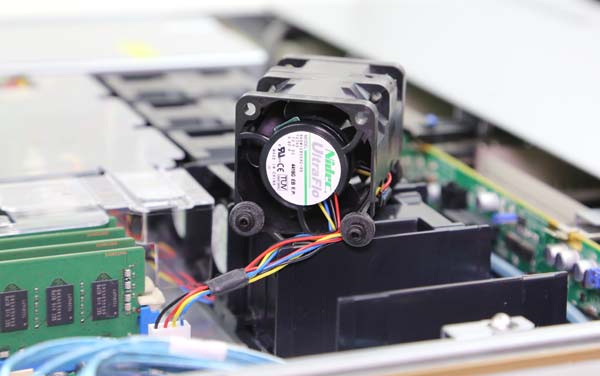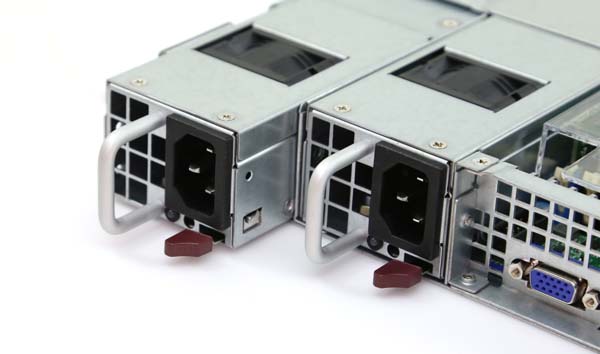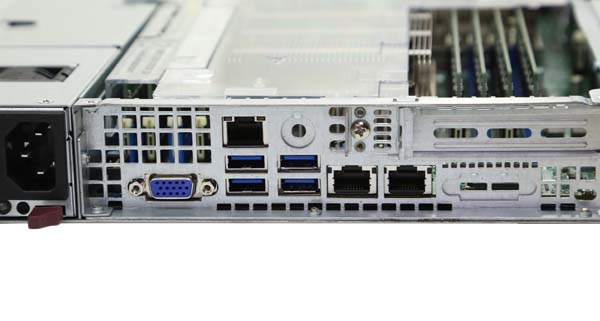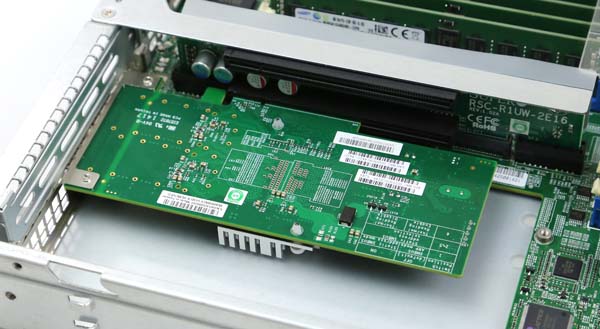Intel Xeon E5-2600 V3 Review: Haswell-EP Redefines Fast
Supermicro SYS-6018R-WTR
The main Xeon E5-2600 v3-based platform we've been using for testing is Supermicro's 1U SYS-6018R-WTR. It's largely an evolution of the SYS-6017R-WRF we already had in the lab. Although this is a 1U format, the server has redundancy built-in, and packs the space with features.
First, as a 1U chassis, there are only so many options for front-mounted storage. This particular chassis exposes four 3.5" front hot-swap bays. In our test system, bays one and two are populated with the Intel SSDs. There are standard LED indicators, as well as power and reset buttons. The rest of the chassis' face serves as a large vent, pulling air in and over the power-hungry components inside.
Redundant fans are responsible for this task. Essentially, two fans are spliced together. If one fails, the other continues to operate. In datacenters, emergency remote hands to replace a fan can cost $100. So, minimizing the need for urgent replacements saves money. Furthermore, with the redundant design, if a fan does fail, the system continues to receive some cooling.
In the same vein of redundancy, there are two 700 W 80 PLUS Platinum-rated PSUs in the rear of the chassis. Low-cost 1U designs, often sporting single Xeon E3s, are usually sold with one power supply to reduce costs. Higher-end servers like this one are meant to be fed with A+B power, and thus have the ability to weather a failure along one of the power delivery routes. That is to say each power supply is fully capable of keeping the server running independently.
The back of the chassis exposes fairly standard I/O. There are two built-in Ethernet ports and one IPMI/KVM-over-IP port for remote management. If you've ever experience a serious failure from a remote location and used KVM-over-IP to troubleshoot, you already know that this feature is awesome. Supermicro also enables four USB ports and a VGA output. Interestingly, this server does not have a dedicated serial port. You can always attach a USB-to-serial adapter if it's really needed.
Inside the server there are two expansion bays. For testing, we used one of the PCIe riser's slots for Supermicro's Fortville-based dual 40 GbE adapter.
Plastic guides ensure that air flows through the 1U heat sinks, RAM, and expansion cards in a focused fashion.
Get Tom's Hardware's best news and in-depth reviews, straight to your inbox.
Our system came equipped with eight 8 GB Samsung DDR4-2133 ECC RDIMMs. When we received the test unit, these were very hard to purchase on the open market. You can see that the server has four memory slots on either side of each processor, totaling 16.
Current page: Supermicro SYS-6018R-WTR
Prev Page How We Tested Next Page Linux-Bench Components And Test Setup-
CaptainTom Wonder how long it is until 18-core CPU's are utilized well in games...Maybe 2018 or 2020?Reply -
dovah-chan ReplyCaptain Tom said:Wonder how long it is until 18-core CPU's are utilized well in games...Maybe 2018 or 2020?
Actually we should be trying to move away from traditional serial-styled processing and move towards parallel processing. Each core can handle only one task at a time and only utilize it's own resources by itself.
This is unlike a GPU, where many processors utilize the same resources and perform multiple tasks at the same time. The problem is that this type of architecture is not supported at all in CPUs and Nvidia is looking for people to learn to program for parallel styled architectures.
But this lineup of CPUs is clearly a marvel of engineering and hard work. Glad to see the server industry will truly start to benefit from the low power and finely-tuned abilities of haswell along with the recently introduced DDR4 which is optimized for low power usage as well. This, combined along with flash-based storage (aka SSDs) which also have lower power drain than the average HDD, will slash through server power bills and save companies literally billions of dollars. Technology is amazing isn't it? -
2Be_or_Not2Be There is still a lot in games that doesn't translate well into parallel processing. A lot of gaming action only happens as a direct result of the user's input, and it usually triggers items that are dependent upon the results from another item. So parallel processing doesn't help a lot there; single-threaded performance helps more.Reply
However, with multiple cores, now we can have better AI and other "off-screen" items that don't necessarily always depend upon the user's direct input. There's still a lot of work to be done there, though. -
2Be_or_Not2Be The new Haswell-EP Xeons are definitely going to help with virtualization. However, I see the high-price of DDR4 and the relative scarcity of it now as being a bit of a handicap to fast adoption, especially since that is one of the major limiting factors to how many servers you can virtualize.Reply
I think all of the major server vendors are going to suck up all of the major memory manufacturers DDR4 capacity for a while before the prices go down. -
balister ReplyThe new Haswell-EP Xeons are definitely going to help with virtualization. However, I see the high-price of DDR4 and the relative scarcity of it now as being a bit of a handicap to fast adoption, especially since that is one of the major limiting factors to how many servers you can virtualize.
I think all of the major server vendors are going to suck up all of the major memory manufacturers DDR4 capacity for a while before the prices go down.
Whether it helps or hinders will ultimately depend on the VM admin. What most VM admins don't realize is that HT can actually end up degrading performance in virtual environments unless the VM admin took specific steps to use HT properly (and most do not). A lot of companies will tell you to turn off HT to increase performance because they've dealt with a lot of VM admins that don't set things up properly (a lot of VM admins over allocate which is part of the reason using HT can degrade performance, but there are other settings as well that have to be set in the Hypervisor so that the guest VMs get the resources they need). -
InvalidError Reply
This is easier said than done since there are tons of everyday algorithms, such as text/code parsing, that are fundamentally incompatible with threading. If you want to build a list or tree using threads, you usually need to split the operation to let each thread work in isolated parts of the list/tree so they do not trip over each other and waste most of their time waiting on mutexes and at the end of the build process, you have a merge process to bring everything back together which is usually not very thread-friendly if you want it to be efficient.14133592 said:Actually we should be trying to move away from traditional serial-styled processing and move towards parallel processing. Each core can handle only one task at a time and only utilize it's own resources by itself.
In many cases, trying to convert algorithms to threads is simply more trouble than it is worth. -
Rob Burns Great to see these processors out, and overall good article. I only wish you used the same benchmark suite you had for the Haswell-E processors: 3DS Max, Adobe Premiere, After Effects, Photoshop. I'd also love to see Vray added to the mix. Not much useful benchmark data in here for 3D professionals. Some good detail on the processors themselves however.Reply -
Drejeck ReplyWonder how long it is until 18-core CPU's are utilized well in games...Maybe 2018 or 2020?
Simply never.
A game is made by sound, logic and graphics. You may dedicate this 3 processes to a number of cores but they remain 3. As you split load some of the logic must recall who did what and where. Logic deals mainly with FPU units, while graphics with integers. GPUs are great integers number crunchers. They have to be fed by the CPU so an extra core manage data through different memories, this is where we start failing. Keeping all in one spot, with the same resources reduces need to transfer data. By implementing a whole processor with GPU, FPU, x86 and sound processor all in one package with on board memory makes for the ultimate gaming processor. As long as we render scenes with triangles we will keep using the legacy stuff. When the time will come to render scenes by pixel we will need a fraction of today's performance, and half of the texture memory (just scale the highest quality) and half of models memory. Epic is already working on that.
-
pjkenned ReplyGreat to see these processors out, and overall good article. I only wish you used the same benchmark suite you had for the Haswell-E processors: 3DS Max, Adobe Premiere, After Effects, Photoshop. I'd also love to see Vray added to the mix. Not much useful benchmark data in here for 3D professionals. Some good detail on the processors themselves however.
Great points. One minor complication is that the NVIDIA GeForce Titan used in the Haswell-E review would not have fit in the 1U servers (let alone be cooled well by then.) Onboard Matrox G200eW graphics are too much of a bottleneck for the standard test suite.
On the other hand, this platform is going to be used primarily in servers. Although there are some really nice workstation options coming, we did not have access in time for testing.
One plus is that you can run the tests directly on your own machine by booting to a Ubuntu 14.04 LTS LiveCD, and issuing three commands. There is a video and the three simple commands here: http://linux-bench.com/howto.html That should give you a rough idea in terms of performance of your system compared to the test systems.
Hopefully we will get some workstation appropriate platforms in the near future where we can run the standard set of TH tests. Thanks for your feedback since it is certainly on the radar.




